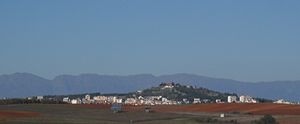Battle of Kilkis (1944)
| Battle of Kilkis | |||||||
|---|---|---|---|---|---|---|---|
| Part of the Greek Civil War | |||||||
 Kilkis in 2012 | |||||||
| |||||||
| Belligerents | |||||||
| ELAS |
Security Battalions EDES EES | ||||||
| Commanders and leaders | |||||||
| Sarantis Protopapas | Kyriakos Papadopoulos (Kisa Batzak) † | ||||||
| Strength | |||||||
| 7,000–10,000[1] | 7,300[1]–9,000[2] | ||||||
The Battle of Kilkis was an armed conflict between communist resistance organisation ELAS and a coalition of collaborationist Security Battalions, nationalist resistance organisations EDES and the National Greek Army (EES). On 4 November 1944, ELAS captured Kilkis after nine hours of fighting. The nationalists suffered many casualties during the battle and in prisoner killings afterwards.
Background
On 28 October 1940, Italy had declared war on Greece, beginning the
In 1943, ELAS began disarming smaller non-communist guerrilla groups and incorporating them in its ranks or disbanding them.
During the closing stages of the Axis occupation, Axis troops withdrew from northern Greece. Fearing reprisals from ELAS, members of the collaborationist Security Battalions, right wing resistance groups (EDES and National Greek Army (EES) and their civilian supporters congregated at Kilkis.[8] The British supervised Caserta Agreement, between ELAS and the Greek government-in-exile, of September 1944 had characterised all units associated with the Security Battalions as enemy combatants and ordered them to surrender to the ΧΙ Division of ELAS.[9] By October 1944, approximately 10,000 people had sought refuge in Kilkis.[10]
Security Battalion commanders debated whether they should entrench themselves in Kilkis or move.[11] The decision was taken to remain in Kilkis, despite the fact that the local population was sympathetic to ELAS.[12] On 30 October, the defenders took positions around Ano Apostoloi, Mesoi Apostoloi and Kato Apostoloi. The following day those positions were harassed by small bands of ELAS fighters.[13] Later on Konstantinos Papadopoulos, one of the most powerful Security Battalion commanders, voiced his disagreement with the way the defences were organised. His unit of 1,500 men left for the village of Mouries, promising to return in the case of an attack on the city.[14]
Battle
On the morning of 4 November, ELAS attacked Kilkis and captured the tactically important Agios Georgios hill. The communists emerged victorious after nine hours of bitter street fighting.[15] ELAS casualties numbered 118 to 180 dead and 410 to 800 wounded and the defenders lost 1,500 killed and 2,190 captured.[16][15] After the battle scores of prisoners were executed in acts of revenge by individual ELAS members; their number has not been accurately estimated. Other prisoners were held in dismal conditions in tobacco warehouses or were transferred to a concentration camp in Thessaloniki.[17] Sources sympathetic to the nationalists put the total number of those killed in action or executed after it at 7,432 dead.[18]
Aftermath
The battle has been noted as the bloodiest clash between communist and nationalist bands in the prelude to the
See also
Notes
- ^ a b Dordanas 2006, p. 495.
- ^ Kalogrias 2012, p. 388.
- ^ Stefanidis 1992, pp. 64–70.
- ^ Close 1995, p. 114.
- ^ Woodhouse 2002, p. 34.
- ^ Close 1995, p. 104.
- ^ Woodhouse 2002, pp. 35, 66.
- ^ Kalogrias & Dordanas 2005, p. 103.
- ^ Dordanas 2006, p. 453.
- ^ Dordanas 2006, p. 487.
- ^ Dordanas 2006, pp. 487–488.
- ^ Kalogrias & Dordanas 2005, p. 173.
- ^ Dordanas 2006, p. 489.
- ^ Kalogrias & Dordanas 2005, pp. 171–173.
- ^ a b Kalogrias & Dordanas 2005, p. 174.
- ^ Dordanas 2006, p. 500.
- ^ Kalogrias & Dordanas 2005, p. 175.
- ^ Dordanas 2012, p. 373.
- ^ Kalogrias & Dordanas 2005, pp. 175–176.
- ^ Dordanas 2012, pp. 373–385.
References
- Close, David H. (1995). The Origins of the Greek Civil War. Addison-Wesley Longman. ISBN 0-582-06471-6.
- Dordanas, Stratos (2006). Έλληνες εναντίον Ελλήνων, Ο κόσμος των Ταγμάτων Ασφαλείας στην κατοχική Θεσσαλονίκη 1941–1944 [Greeks versus Greeks, The world of Security Battalions in occupied Thessaloniki 1941–1944] (in Greek). Thessaloniki: Epikentro. ISBN 960-6647-31-5.
- Dordanas, Stratos (2012). Η γερμανική στολή στη ναφθαλίνη, Επιβιώσεις του δοσιλογισμού στη Μακεδονία, 1945–1974 [German uniform in naphthalene, Remnants of collaborationism in Macedonia, 1945–1974] (in Greek). Athens: Estia. ISBN 978-960-05-1511-4.
- Kalogrias, Vaios; Dordanas, Stratos (2005). Οι άλλοι καπετάνιοι, Αντικομουνιστές ένοπλοι στα χρόνια της Κατοχής και του Εμφυλίου [The Other Commanders, Anticommunist Insurgents During the Years of the Occupation and the Civil War] (in Greek). Athens: Estia. ISBN 978-960-05-1237-3.
- Kalogrias, Vaios (2012). Το αντίπαλο δέος, Οι εθνικιστικές οργανώσεις αντίστασης στην κατεχόμενη Μακεδονία (1941–1944) [Fear of the enemy, Nationalist organisations in occupied Macedonia (1941–1944)] (in Greek). Thessaloniki: University Studio Press. ISBN 978-960-12-2076-5.
- Stefanidis, Yiannis (1992). "Macedonia in the 1940s" (PDF). Modern and Contemporary Macedonia. 2: 64–103. Retrieved 8 May 2016.
- ISBN 1-85065-492-1.
